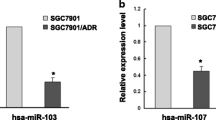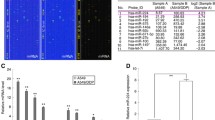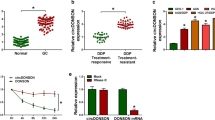Abstract
Purpose
MicroRNAs (miRNAs) are short non-coding RNA molecules, which post-transcriptionally regulate genes expression and play crucial roles in diverse biological processes. Recent studies have shown that dysregulation of miRNAs might modulate the resistance of cancer cells to anti-cancer drugs, yet the modulation mechanism is not fully understood. We aimed to investigate the possible role of miRNAs in the development of multidrug resistance (MDR) in human gastric and lung cancer cell lines.
Methods
miRNA Quantitative real-time PCR was used to detect the different miRNA expression levels between drug resistant and parental cancer cells. MTT (3-(4,5-dimethylthiazol-2-yl)-2,5-diphenyltetrazolium bromide) assay was used to test the drug-resistant phenotype changes in cancer cells via over or downregulation of miRNAs. Dual-luciferase activity assay was used to verify the target genes of miRNAs. Western blot analysis and apoptosis assay were used to elucidate the mechanism of miRNAs on modulating drug resistance in cancer cells.
Results
miR-200bc/429 cluster was downregulated, while BCL2 and XIAP were upregulated in both MDR SGC7901/VCR (vincristine) and A549/CDDP (cisplatin) cells, compared with the parental SGC7901 and A549 cells, respectively. Overexpression of miR-200bc/429 cluster sensitized SGC7901/VCR and A549/CDDP cells to anti-cancer drugs, respectively. Both BCL2 and XIAP 3′-UTR reporters constructed in MDR cells suggested that BCL2 and XIAP were the common target genes of the miR-200bc/429 cluster. Enforced miR-200bc/429 cluster expression reduced BCL2 and XIAP protein level and sensitized both MDR cells to VCR-induced and CDDP-induced apoptosis, respectively.
Conclusions
Our findings first suggest that miR-200bc/429 cluster could play a role in the development of MDR in both gastric and lung cancer cell lines, at least in part by modulation of apoptosis via targeting BCL2 and XIAP.




Similar content being viewed by others
Abbreviations
- miRNAs:
-
MicroRNAs
- MDR:
-
Multidrug resistance
- VCR:
-
Vincristine
- CDDP:
-
Cisplatin
- ADR:
-
Adriamycin
- 5-Fu:
-
5-Fluorouracil
- VP-16:
-
Etoposide
References
Szakacs G, Paterson JK, Booth-Genthe C, Gottesman MM (2006) Targeting multidrug resistance in cancer. Nat Rev Drug Discov 5:219–234
Rabik CA, Dolan ME (2007) Molecular mechanisms of resistance and toxicity associated with platinating agents. Cancer Treat Rev 33:9–23
Johnstone RW, Ruefli AA, Lowe SW (2002) Apoptosis: a link between cancer genetics and chemotherapy. Cell 108:153–164
Zhang K, Mack P, Wong KP (1998) Glutathione-related mechanisms in cellular resistance to anticancer drugs. Int J Oncol 12:871–882
Fojo T (2007) Multiple paths to a drug resistance phenotype: mutations, translocations, deletions and amplification of coding genes or promoter regions, epigenetic changes and microRNAs. Drug Resist Updat 10(1–2):59–67
Glasspool RM, Teodoridis JM, Brown R (2006) Epigenetics as a mechanism driving polygenic clinical drug resistance. Br J Cancer 94(8):1087–1092
Sharma SV, Lee DY, Li B, Quinlan MP, Takahashi F, Maheswaran S, McDermott U, Azizian N, Zou L, Fischbach MA, Wong KK, Brandstetter K, Wittner B, Ramaswamy S, Classon M, Settleman J (2010) A chromatin-mediated reversible drug-tolerant state in cancer cell subpopulations. Cell 141(1):69–80
Lee RC, Feinbaum RL, Ambros V (1993) The C. elegans heterochronic gene lin-4 encodes small RNAs with antisense complementarity to lin-14. Cell 75(5):843–854
Zheng T, Wang J, Chen X, Liu L (2010) Role of microRNA in anticancer drug resistance. Int J Cancer 126:2–10
Hummel R, Hussey DJ, Haier J (2010) MicroRNAs: predictors and modifiers of chemo- and radiotherapy in different tumour types. Eur J Cancer 46(2):298–311
Ma J, Dong C, Ji C (2010) MicroRNA and drug resistance. Cancer Gene Ther 17(8):523–531
Sarkar FH, Li Y, Wang Z, Kong D, Ali S (2010) Implication of microRNAs in drug resistance for designing novel cancer therapy. Drug Resist Updat 13(3):57–66
Chen GQ, Zhao ZW, Zhou HY, Liu YJ, Yang HJ (2010) Systematic analysis of microRNA involved in resistance of the MCF-7 human breast cancer cell to doxorubicin. Med Oncol 27(2):406–415
Bourguignon LY, Spevak CC, Wong G, Xia W, Gilad E (2009) Hyaluronan-CD44 interaction with protein kinase C (epsilon) promotes oncogenic signaling by the stem cell marker Nanog and the Production of microRNA-21, leading to down-regulation of the tumor suppressor protein PDCD4, anti-apoptosis, and chemotherapy resistance in breast tumor cells. J Biol Chem 284(39):26533–26546
Li Y, Li W, Yang Y, Lu Y, He C, Hu G, Liu H, Chen J, He J, Yu H (2009) MicroRNA-21 targets LRRFIP1 and contributes to VM-26 resistance in glioblastoma multiforme. Brain Res 1286:13–18
Song B, Wang Y, Xi Y, Kudo K, Bruheim S, Botchkina GI, Gavin E, Wan Y, Formentini A, Kornmann M, Fodstad O, Ju J (2009) Mechanism of chemoresistance mediated by miR-140 in human osteosarcoma and colon cancer cells. Oncogene 28(46):4065–4074
Tsang WP, Kwok TT (2008) Let-7a microRNA suppresses therapeutics-induced cancer cell death by targeting caspase-3. Apoptosis 13:1215–1222
Zhu W, Shan X, Wang TS, Shu YQ, Liu P (2010) miR-181b modulates multidrug resistance by targeting BCL2 in human cancer cell lines. Int J Cancer 127(11):2520–2529
Xia L, Zhang D, Du R, Pan Y, Zhao L, Sun S, Hong L, Liu J, Fan D (2008) miR-15b and miR-16 modulate multidrug resistance by targeting BCL2 in human gastric cancer cells. Int J Cancer 123:372–379
Zhu W, Zhu D, Lu S, Wang T, Wang J, Jiang B, Shu Y, Liu P (2011) miR-497 modulates multidrug resistance of human cancer cell lines by targeting BCL2. Med Oncol 2011 Jan 22 (Epub ahead of print)
Livak KJ, Schmittgen TD (2001) Analysis of relative gene expression data using real-time quantitative PCR and the 2(-Delta Delta C(T)) method. Methods 25:402–408
Yamaue H, Tanimura H, Noguchi K, Hotta T, Tani M, Tsunoda T, Iwahashi M, Tamai M, Iwakura S (1992) Chemosensitivity testing of fresh human gastric cancer with highly purified tumor cells using the MTT assay. Br J Cancer 66:794–799
Yamaue H, Tani M, Onishi H, Kinoshita H, Nakamori M, Yokoyama S, Iwahashi M, Uchiyama K (2002) Locoregional chemotherapy for patients with pancreatic cancer intraarterial adjuvant chemotherapy after pancreatectomy with portal vein resection. Pancreas 25:366–372
Wang S, Yang D, Lippman ME (2003) Targeting Bcl-2 and Bcl-XL with nonpeptidic small-molecule antagonists. Semin Oncol 30:133–142
Reed JC (2006) Drug insight: cancer therapy strategies based on restoration of endogenous cell death mechanisms. Nat Clin Prac Oncol 3:388–398
Uhlmann S, Zhang JD, Schwäger A, Mannsperger H, Riazalhosseini Y, Burmester S, Ward A, Korf U, Wiemann S, Sahin O (2010) miR-200bc/429 cluster targets PLCgamma1 and differentially regulates proliferation and EGF-driven invasion than miR-200a/141 in breast cancer. Oncogene 29(30):4297–4306
Baffa R, Fassan M, Volinia S, O’Hara B, Liu CG, Palazzo JP, Gardiman M, Rugge M, Gomella LG, Croce CM, Rosenberg A (2009) MicroRNA expression profiling of human metastatic cancers identifies cancer gene targets. J Pathol 219(2):214–221
Hu X, Macdonald DM, Huettner PC, Feng Z, El Naqa IM, Schwarz JK, Mutch DG, Grigsby PW, Powell SN, Wang X (2009) A miR-200 microRNA cluster as prognostic marker in advanced ovarian cancer. Gynecol Oncol 114(3):457–464
Gregory PA, Bert AG, Paterson EL, Barry SC, Tsykin A, Farshid G, Vadas MA, Khew-Goodall Y, Goodall GJ (2008) The miR-200 family and miR-205 regulate epithelial to mesenchymal transition by targeting ZEB1 and SIP1. Nat Cell Biol 10(5):593–601
Kong D, Li Y, Wang Z, Banerjee S, Ahmad A, Kim HR, Sarkar FH (2009) miR-200 regulates PDGF-D-mediated epithelial-mesenchymal transition, adhesion, and invasion of prostate cancer cells. Stem Cells 27(8):1712–1721
Li Y, VandenBoom TG 2nd, Kong D, Wang Z, Ali S, Philip PA, Sarkar FH (2009) Up-regulation of miR-200 and let-7 by natural agents leads to the reversal of epithelial-to-mesenchymal transition in gemcitabine-resistant pancreatic cancer cells. Cancer Res 69(16):6704–6712
Adam L, Zhong M, Choi W, Qi W, Nicoloso M, Arora A, Calin G, Wang H, Siefker-Radtke A, McConkey D, Bar-Eli M, Dinney C (2009) miR-200 expression regulates epithelial-to-mesenchymal transition in bladder cancer cells and reverses resistance to epidermal growth factor receptor therapy. Clin Cancer Res 15(16):5060–5072
Pogribny IP, Filkowski JN, Tryndyak VP, Golubov A, Shpyleva SI, Kovalchuk O (2010) Alterations of microRNAs and their targets are associated with acquired resistance of MCF-7 breast cancer cells to cisplatin. Int J Cancer 127:1785–1794
Li A, Omura N, Hong SM, Vincent A, Walter K, Griffith M, Borges M, Goggins M (2010) Pancreatic cancers epigenetically silence SIP1 and hypomethylate and overexpress miR-200a/200b in association with elevated circulating miR-200a and miR-200b levels. Cancer Res 70(13):5226–5237
Neves R, Scheel C, Weinhold S, Honisch E, Iwaniuk KM, Trompeter HI, Niederacher D, Wernet P, Santourlidis S, Uhrberg M (2010) Role of DNA methylation in miR-200c/141 cluster silencing in invasive breast cancer cells. BMC Res Notes 3:219
Wiklund ED, Bramsen JB, Hulf T, Dyrskjøt L, Ramanathan R, Hansen TB, Villadsen SB, Gao S, Ostenfeld MS, Borre M, Peter ME, Orntoft TF, Kjems J, Clark SJ (2011) Coordinated epigenetic repression of the miR-200 family and miR-205 in invasive bladder cancer. Int J Cancer 128(6):1327–1334
Vrba L, Jensen TJ, Garbe JC, Heimark RL, Cress AE, Dickinson S, Stampfer MR, Futscher BW (2010) Role for DNA methylation in the regulation of miR-200c and miR-141 expression in normal and cancer cells. PLoS One 5(1):e8697
Rui W, Bing F, Hai-Zhu S, Wei D, Long-Bang C (2010) Identification of microRNA profiles in docetaxel-resistant human non-small cell lung carcinoma cells (SPC-A1). J Cell Mol Med 14(1–2):206–214
Meng F, Henson R, Lang M et al (2006) Involvement of human micro-RNA in growth and response to chemotherapy in human cholangiocarcinoma cell lines. Gastroenterology 130(7):2113–2129
Houghton JA, Harwood FG, Tillman DM (1997) Thymineless death in colon carcinoma cells is mediated via Fas signaling. Proc Natl Acad Sci USA 94:8144–8149
Acknowledgments
The authors are grateful to the fund supported by the National Natural Science Foundation of China (Grant number: 30840095) and the Cancer Center of Nanjing Medical University (Grant number: 08ZLKF02).
Author information
Authors and Affiliations
Corresponding author
Additional information
Wei Zhu and Huaguo Xu contributed equally.
Electronic supplementary material
Below is the link to the electronic supplementary material.
Rights and permissions
About this article
Cite this article
Zhu, W., Xu, H., Zhu, D. et al. miR-200bc/429 cluster modulates multidrug resistance of human cancer cell lines by targeting BCL2 and XIAP. Cancer Chemother Pharmacol 69, 723–731 (2012). https://doi.org/10.1007/s00280-011-1752-3
Received:
Accepted:
Published:
Issue Date:
DOI: https://doi.org/10.1007/s00280-011-1752-3




